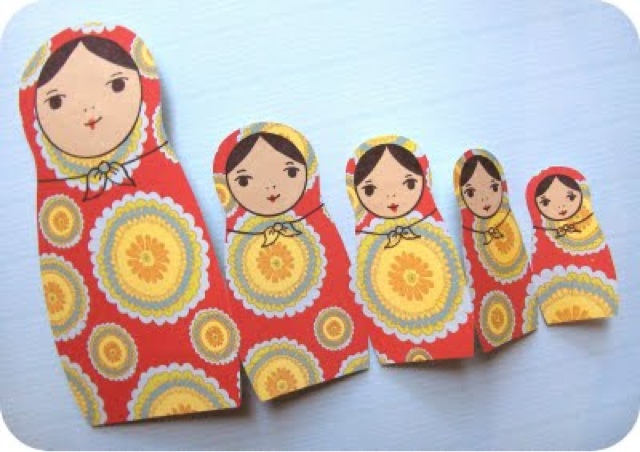When it gets to be close to Thanksgiving, I have a favorite lesson I like to use with my 3rd or 4 th graders. I read One Grain of Rice, by Demi. This book explores many themes, from the mathematical concept of geometric growth, to hunger, crop dependence, and famine. The students are always astonished at how a single grain of rice, doubled each day, can become a monumental quantity.
It’s always a good idea to bring students a simple way they can make a difference in the world. The site FreeRice.com donates rice as the students play a game of vocabulary, simple math, or other subjects. The game adjusts in difficulty level depending on how many questions are answered correctly. It’s quite an addictive game!
The book, followed by introducing and playing the associated game, is a two-period plan. Many students will go home and play. They love to report how much rice they donated.
Monday, November 26, 2012
Matryoshka Doll Story
One of my favorite books to read aloud this time of year is Matreshka by Ayers. I have a set of dolls that were given to me by my uncle, after he travelled through the Ukraine. As I read the story, I sing-song the parts for the little doll (kids LOVE the repeating phrases). At the proper intervals, I spin the doll 3 times, and the next smallest "sister" appears, just in time to solve a problem for the heroine of the tale.
Here's a summary from School Library Journal :
Kindergarten-Grade 3-- Drawing upon traditional Russian folklore, Ayres creates an accessible and exciting picture book in which a young girl outwits the evil Baba Yaga. After sharing her meal with an old woman she meets on the road, Kata is given a little wooden doll named Matreshka. Lost in a snowstorm, the child stumbles upon the witch's fearsome house and is given a room for the evening. When Kata realizes she's to be Baba Yaga's next meal, the wooden doll saves her life. Out of the larger Matreshka pop four smaller dolls who find a way out of locked doors, crawl through a mouse's hole, and confuse the witch so thoroughly that she accidently turns herself into a green frog. Natchev's bold, lively illustrations occupy double-page spreads and have a fresh, often whimsical look. The watercolor washes boast a variety of textures, and the characters are depicted in an exaggerated manner. Unfortunately, there is a lack of agreement between text and illustration at the beginning of the book. The text has Kata returning from a trip to town while the illustrations show her just leaving her grandfather's house. Even so, the story will have wide appeal and is suitable for sharing aloud or reading independently. It also makes an entertaining introduction to Russian folklore and culture, especially if told using a set of Russian nesting dolls. --Denise Anton Wright, Illinois State University, Normal
I found a darling craft project that the kids could do with pretty paper... http://zakkalife.blogspot.com/2009/11/craft-project-russian-nesting-doll-card.html
Here's a summary from School Library Journal :
Kindergarten-Grade 3-- Drawing upon traditional Russian folklore, Ayres creates an accessible and exciting picture book in which a young girl outwits the evil Baba Yaga. After sharing her meal with an old woman she meets on the road, Kata is given a little wooden doll named Matreshka. Lost in a snowstorm, the child stumbles upon the witch's fearsome house and is given a room for the evening. When Kata realizes she's to be Baba Yaga's next meal, the wooden doll saves her life. Out of the larger Matreshka pop four smaller dolls who find a way out of locked doors, crawl through a mouse's hole, and confuse the witch so thoroughly that she accidently turns herself into a green frog. Natchev's bold, lively illustrations occupy double-page spreads and have a fresh, often whimsical look. The watercolor washes boast a variety of textures, and the characters are depicted in an exaggerated manner. Unfortunately, there is a lack of agreement between text and illustration at the beginning of the book. The text has Kata returning from a trip to town while the illustrations show her just leaving her grandfather's house. Even so, the story will have wide appeal and is suitable for sharing aloud or reading independently. It also makes an entertaining introduction to Russian folklore and culture, especially if told using a set of Russian nesting dolls. --Denise Anton Wright, Illinois State University, Normal
I found a darling craft project that the kids could do with pretty paper... http://zakkalife.blogspot.com/2009/11/craft-project-russian-nesting-doll-card.html
Subscribe to:
Comments (Atom)




